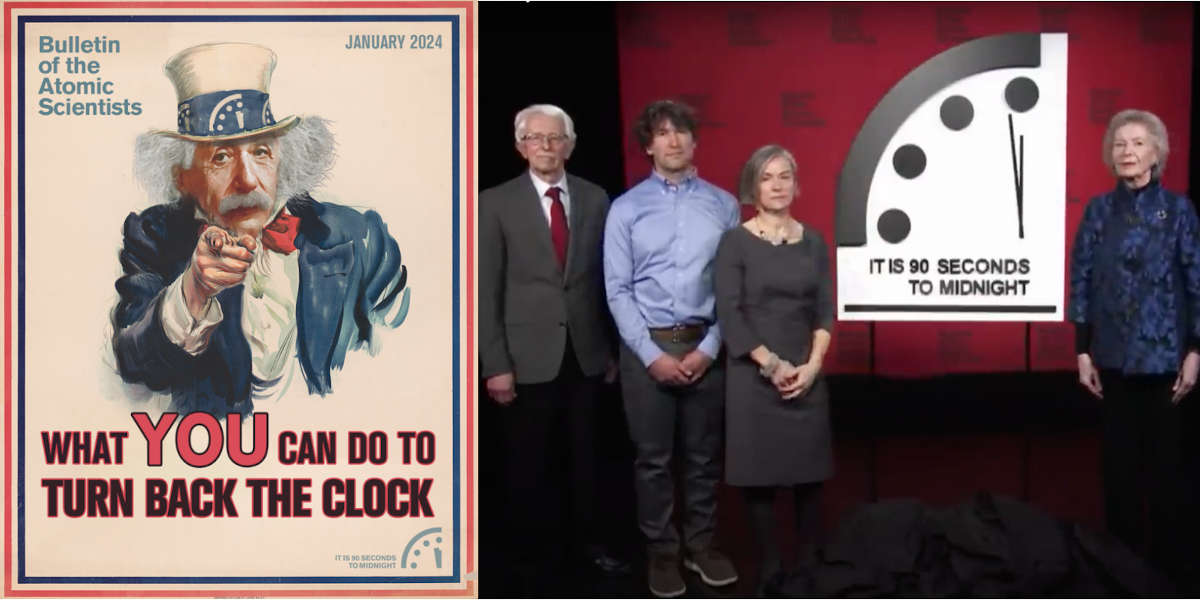En la imagen
Poster and video footage produced by the Bulletin of the Atomic Scientists [BoAS]
Known as a metaphorical symbol of humanity’s vulnerability to existential risks, the Doomsday Clock serves as a reminder of the critical challenges that must be addressed to ensure the security of humanity. Developed in 1947, this tool administered by the Bulletin of the Atomic Scientists, managed to point out the presence of nuclear weapons in both the United States of America and the Soviet Union. It ended up elevating the level of danger to humanity, as both nations engaged in a nuclear arms race. The presence of such a tool serves as a powerful symbol, emphasising the imminent threat of human induced global disaster, mainly through nuclear warfare. However, it also presents an opportunity to re-evaluate and reform global nuclear policies, fostering a more secure and peaceful world.
The most recent resets of the clock have been disturbing: two minutes to midnight in 2018 (the same amount of time than in 1953-1959, the previous most risky period), 100 seconds to midnight in 2020... and just 90 seconds to midnight since 2023.
Some insight into the Doomsday Clock
Aiming to warn the public about the insecurity of nuclear weapons, the concept of the Doomsday Clock originated in 1947 with the Bulletin of the Atomic Scientists. Their main aim was to engage with other scientistsregarding the moral and social obligations associated with nuclear energy, and at the same time educate the general public about the potential implications.
Decisions regarding the clock’s time were initially made by the Bulletins editor in chief, Eugene Rabinowithch, a Russian American Physicist also known as a prominent leader in the global disarmament movement. Such decisions were—and are still—based on discussions with other scientists and government experts considering both political and technological developments.
Upon his death in 1973, the Science and Security Board (SASB) of the Bulletin of Atomic Scientists assumed responsibility for changing the Doomsday Clock’s minute hand. It is important to point out that the signing of the Strategic Arms Reduction Treaty (START) in 1991 reset the clock to 17 minutes to midnight, the furthest it had ever been, as it was an agreement to reduce both nations nuclear weapons arsenals.
Nowadays, the board is composed of nuclear technology and climate science specialists, who meet twice a year to assess global circumstances and decide whether to adjust the clock.
Not just about nukes: Other human threats considered
Over time, the clock’s scope has evolved and now concentrates on three primary areas: firstly, climate change; secondly, disruptive technologies, and lastly, nuclear risk. The common thread linking these subjects is the fundamental belief that, since humans are responsible for creating these issues, we have the ability to manage them.
In terms of climate change, the year 2023 marked the hottest year on record and rising global greenhouse gas emissions. Despite The Paris Agreement sought to strengthen the global response to the threat of climate change, the world is at risk of limiting temperature increase to 1.5 degrees Celsius above pre-industrial level given the inadequate emission reduction commitments. Present attempts to reduce greenhouse gas emissions fall short, with the poorest people suffering the most from climate change. Without significant improvements in mitigation measures, human suffering from climate change will continue to worsen.
Moreover, concerning biological threats, the recent developments in life sciences and related technologies are increasing the likelihood of both unintentional and intentional abuse of biological materials. The merging of artificial intelligence with biological technology has raised worries about the improper use of biology, since artificial intelligence may enable the development of hazardous biological entities. In October 2023, the president of the United States, Joe Biden, signed an Executive order seeking to ensure a “safe, secure, and trustworthy AI,” which calls for guidelines to prevent AI from developing hazardous biological material. Yet, these norms are not legally binding and provide restricted deterrence.
Also, we must consider the accidental laboratory discharges and infectious illnesses which both contribute to the hazards. These hazards are exacerbated by factors such as deforestation, urbanisation, climate change, and inadequate monitoring of biosafety laboratories.
In 2023, the major development in terms of technological disruption was arguably artificial intelligence. On the one hand, it has the capacity to corrupt information ecosystems, posing a threat to democracy. However, it is rapidly being employed in the military. Despite there being regulatory measures implemented globally, issues still remain.
With reference to the nuclear threats, last year has witnessed difficult ties amongst powerful nations, all of which are engaged in modernising their nuclear arsenal, while the arms control framework collapses. Going back to the Russian conflict in Ukraine, in terms of nuclear threats, it continues to be considered a source of tension, mostly because of the possibilities of using nuclear weapons. Russian President Vladimir Putin announced in February 2023 that he would suspend the new START treaty, which was the only remaining Russia-U.S arms reduction treaty. Amongst other concerning developments, North Korea continues to advance its nuclear program, by testing a solid fuel intercontinental ballistic missile (ICBM), and prompting South Korea to seek greater US commitment.
Overall, it signifies the potential for a worldwide catastrophe, particularly from climate change, disruptive technologies and, of course, nuclear risk. However, it also offers an opportunity to review global policies, promoting a safer global environment.


